SATURN RELAY 2007 Owners Manual
Manufacturer: SATURN, Model Year: 2007, Model line: RELAY, Model: SATURN RELAY 2007Pages: 570, PDF Size: 3.41 MB
Page 141 of 570

2. If the engine does not start in 10 seconds,
push the accelerator pedal about one-quarter
of the way down while you turn the key to
START. Do this until the engine starts.
As soon as it does, let go of the key.
3. If your engine still will not start, or starts but
then stops, it could be �ooded with too much
gasoline. Try pushing your accelerator
pedal all the way to the �oor and holding it
there as you hold the key in START for
a maximum of 15 seconds. This clears the
extra gasoline from the engine. If the engine
still will not start, or starts brie�y but then
stops again, repeat Step 1 or 2, depending on
the temperature. When the engine starts,
release the key and the accelerator pedal.
Notice:Your engine is designed to work with
the electronics in your vehicle. If you add
electrical parts or accessories, you could
change the way the engine operates. Before
adding electrical equipment, check with
your Saturn retailer. If you do not, your engine
might not perform properly. Any resulting
damage would not be covered by your
vehicle’s warranty.Engine Coolant Heater
Your vehicle may have an engine coolant heater.
In very cold weather, 0°F (−18°C) or colder,
the engine coolant heater can help. You will get
easier starting and better fuel economy during
engine warm-up. Usually, the coolant heater
should be plugged in a minimum of four hours
prior to starting your vehicle. At temperatures
above 32°F (0°C), use of the coolant heater is not
required. Your vehicle may also have an internal
thermostat in the plug end of the cord. This
will prevent operation of the engine coolant heater
when the temperature is at or above 0°F (−18°C)
as noted on the cord.
141
ProCarManuals.com
Page 142 of 570

To Use the Engine Coolant Heater
1. Turn off the engine.
2. Open the hood and unwrap the electrical
cord. The electrical cord is located on the
driver’s side of the engine compartment.
3. Plug it into a normal, grounded 110-volt AC
outlet.
{CAUTION:
Plugging the cord into an ungrounded
outlet could cause an electrical shock.
Also, the wrong kind of extension cord
could overheat and cause a �re. You
could be seriously injured. Plug the cord
into a properly grounded three-prong
110-volt AC outlet. If the cord will not
reach, use a heavy-duty three-prong
extension cord rated for at least 15 amps.4. Before starting the engine, be sure to unplug
and store the cord as it was before to keep it
away from moving engine parts. If you do
not, it could be damaged.
How long should you keep the coolant heater
plugged in? The answer depends on the outside
temperature, the kind of oil you have, and
some other things. Instead of trying to list
everything here, we ask that you contact your
retailer in the area where you will be parking your
vehicle. The retailer can give you the best
advice for that particular area.
142
ProCarManuals.com
Page 143 of 570
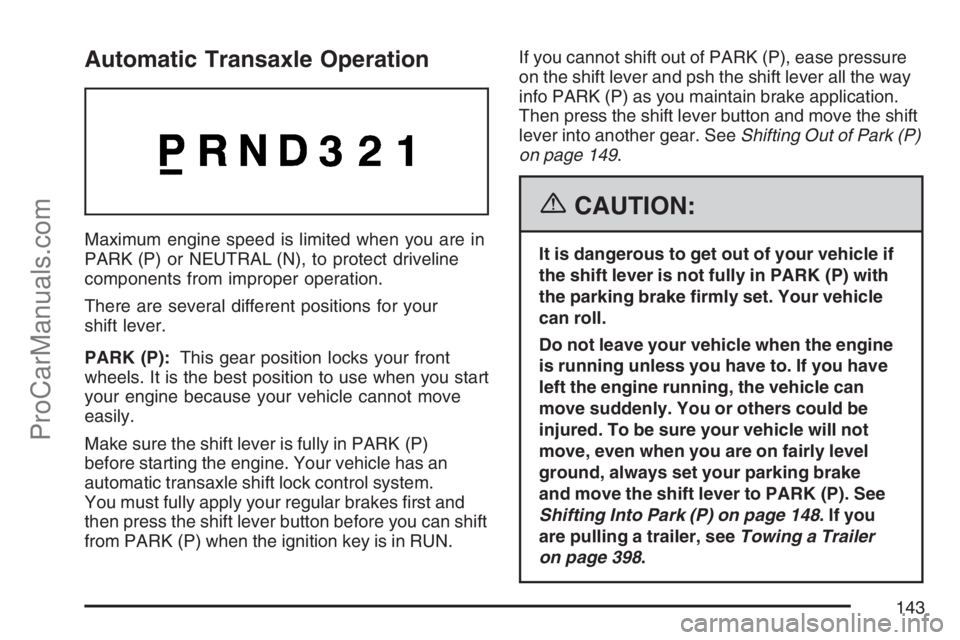
Automatic Transaxle Operation
Maximum engine speed is limited when you are in
PARK (P) or NEUTRAL (N), to protect driveline
components from improper operation.
There are several different positions for your
shift lever.
PARK (P):This gear position locks your front
wheels. It is the best position to use when you start
your engine because your vehicle cannot move
easily.
Make sure the shift lever is fully in PARK (P)
before starting the engine. Your vehicle has an
automatic transaxle shift lock control system.
You must fully apply your regular brakes �rst and
then press the shift lever button before you can shift
from PARK (P) when the ignition key is in RUN.If you cannot shift out of PARK (P), ease pressure
on the shift lever and psh the shift lever all the way
info PARK (P) as you maintain brake application.
Then press the shift lever button and move the shift
lever into another gear. SeeShifting Out of Park (P)
on page 149.
{CAUTION:
It is dangerous to get out of your vehicle if
the shift lever is not fully in PARK (P) with
the parking brake �rmly set. Your vehicle
can roll.
Do not leave your vehicle when the engine
is running unless you have to. If you have
left the engine running, the vehicle can
move suddenly. You or others could be
injured. To be sure your vehicle will not
move, even when you are on fairly level
ground, always set your parking brake
and move the shift lever to PARK (P). See
Shifting Into Park (P) on page 148.Ifyou
are pulling a trailer, seeTowing a Trailer
on page 398.
143
ProCarManuals.com
Page 144 of 570

REVERSE (R):Use this gear to back up.
Notice:Shifting to REVERSE (R) while your
vehicle is moving forward could damage
the transaxle. The repairs would not be
covered by your warranty. Shift to
REVERSE (R) only after your vehicle is
stopped.
To rock your vehicle back and forth to get out
of snow, ice or sand without damaging your
transaxle, seeIf Your Vehicle is Stuck in Sand,
Mud, Ice, or Snow on page 390.
NEUTRAL (N):In this position, your engine does
not connect with the wheels. To restart when
you are already moving, use NEUTRAL (N) only.
Also, use NEUTRAL (N) when your vehicle is
being towed.
{CAUTION:
Shifting into a drive gear while your
engine is running at high speed is
dangerous. Unless your foot is �rmly on
the brake pedal, your vehicle could move
very rapidly. You could lose control and
hit people or objects. Do not shift into a
drive gear while your engine is running at
high speed.
Notice:Shifting out of PARK (P) or
NEUTRAL (N) while the engine is running at
high speed may damage the transaxle.
The repairs would not be covered by your
warranty. Be sure the engine is not running at
high speeds when shifting your vehicle.
144
ProCarManuals.com
Page 145 of 570
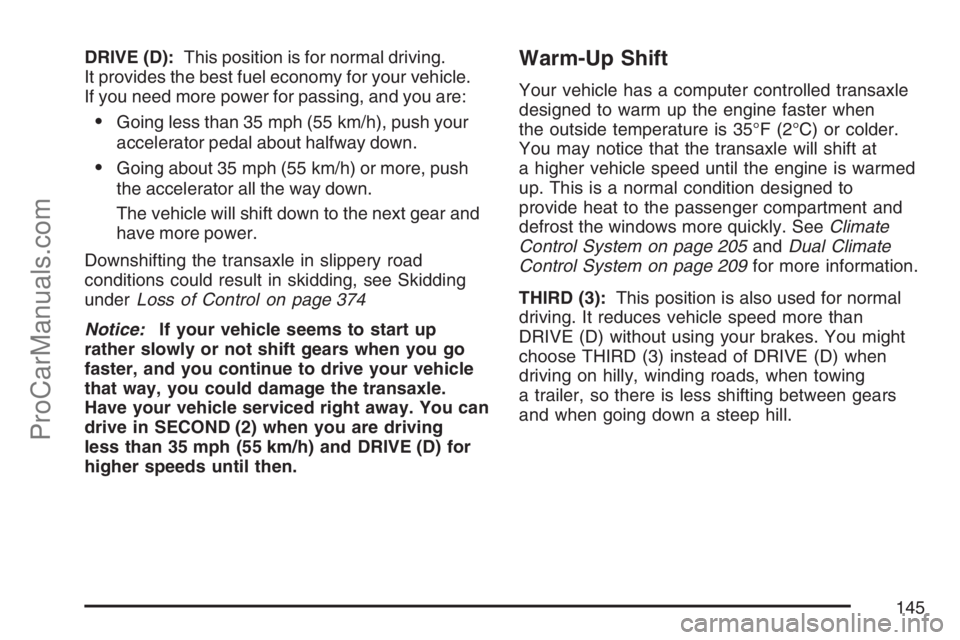
DRIVE (D):This position is for normal driving.
It provides the best fuel economy for your vehicle.
If you need more power for passing, and you are:
Going less than 35 mph (55 km/h), push your
accelerator pedal about halfway down.
Going about 35 mph (55 km/h) or more, push
the accelerator all the way down.
The vehicle will shift down to the next gear and
have more power.
Downshifting the transaxle in slippery road
conditions could result in skidding, see Skidding
underLoss of Control on page 374
Notice:If your vehicle seems to start up
rather slowly or not shift gears when you go
faster, and you continue to drive your vehicle
that way, you could damage the transaxle.
Have your vehicle serviced right away. You can
drive in SECOND (2) when you are driving
less than 35 mph (55 km/h) and DRIVE (D) for
higher speeds until then.
Warm-Up Shift
Your vehicle has a computer controlled transaxle
designed to warm up the engine faster when
the outside temperature is 35°F (2°C) or colder.
You may notice that the transaxle will shift at
a higher vehicle speed until the engine is warmed
up. This is a normal condition designed to
provide heat to the passenger compartment and
defrost the windows more quickly. SeeClimate
Control System on page 205andDual Climate
Control System on page 209for more information.
THIRD (3):This position is also used for normal
driving. It reduces vehicle speed more than
DRIVE (D) without using your brakes. You might
choose THIRD (3) instead of DRIVE (D) when
driving on hilly, winding roads, when towing
a trailer, so there is less shifting between gears
and when going down a steep hill.
145
ProCarManuals.com
Page 146 of 570
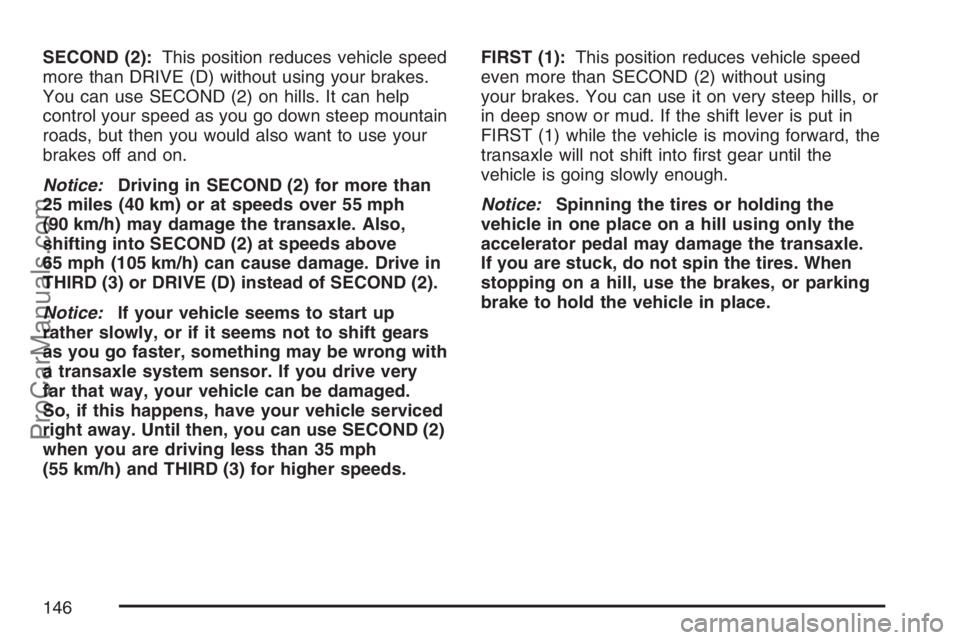
SECOND (2):This position reduces vehicle speed
more than DRIVE (D) without using your brakes.
You can use SECOND (2) on hills. It can help
control your speed as you go down steep mountain
roads, but then you would also want to use your
brakes off and on.
Notice:Driving in SECOND (2) for more than
25 miles (40 km) or at speeds over 55 mph
(90 km/h) may damage the transaxle. Also,
shifting into SECOND (2) at speeds above
65 mph (105 km/h) can cause damage. Drive in
THIRD (3) or DRIVE (D) instead of SECOND (2).
Notice:If your vehicle seems to start up
rather slowly, or if it seems not to shift gears
as you go faster, something may be wrong with
a transaxle system sensor. If you drive very
far that way, your vehicle can be damaged.
So, if this happens, have your vehicle serviced
right away. Until then, you can use SECOND (2)
when you are driving less than 35 mph
(55 km/h) and THIRD (3) for higher speeds.FIRST (1):This position reduces vehicle speed
even more than SECOND (2) without using
your brakes. You can use it on very steep hills, or
in deep snow or mud. If the shift lever is put in
FIRST (1) while the vehicle is moving forward, the
transaxle will not shift into �rst gear until the
vehicle is going slowly enough.
Notice:Spinning the tires or holding the
vehicle in one place on a hill using only the
accelerator pedal may damage the transaxle.
If you are stuck, do not spin the tires. When
stopping on a hill, use the brakes, or parking
brake to hold the vehicle in place.
146
ProCarManuals.com
Page 147 of 570
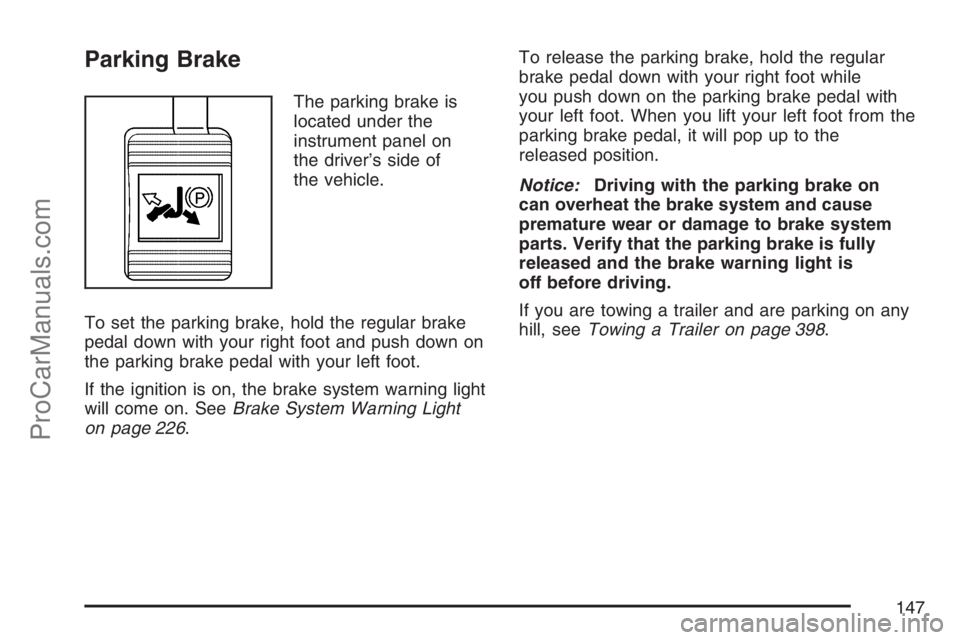
Parking Brake
The parking brake is
located under the
instrument panel on
the driver’s side of
the vehicle.
To set the parking brake, hold the regular brake
pedal down with your right foot and push down on
the parking brake pedal with your left foot.
If the ignition is on, the brake system warning light
will come on. SeeBrake System Warning Light
on page 226.To release the parking brake, hold the regular
brake pedal down with your right foot while
you push down on the parking brake pedal with
your left foot. When you lift your left foot from the
parking brake pedal, it will pop up to the
released position.
Notice:Driving with the parking brake on
can overheat the brake system and cause
premature wear or damage to brake system
parts. Verify that the parking brake is fully
released and the brake warning light is
off before driving.
If you are towing a trailer and are parking on any
hill, seeTowing a Trailer on page 398.
147
ProCarManuals.com
Page 148 of 570

Shifting Into Park (P)
{CAUTION:
It can be dangerous to get out of your
vehicle if the shift lever is not fully in
PARK (P) with the parking brake �rmly set.
Your vehicle can roll. If you have left the
engine running, the vehicle can move
suddenly. You or others could be injured.
To be sure your vehicle will not move, even
when you are on fairly level ground, use
the steps that follow. If you are pulling a
trailer, seeTowing a Trailer on page 398.
1. Hold the brake pedal down with your right foot
and set the parking brake with your left foot.
2. Move the shift lever into PARK (P) by pulling
the shift lever toward you and moving it up as
far as it will go.
3. Turn the ignition key to LOCK.
4. Remove the key and take it with you. If you
can leave your vehicle with the ignition key in
your hand, your vehicle is in PARK (P).
Leaving Your Vehicle With the
Engine Running
{CAUTION:
It can be dangerous to leave your vehicle
with the engine running. Your vehicle
could move suddenly if the shift lever is
not fully in PARK (P) with the parking
brake �rmly set. And, if you leave the
vehicle with the engine running, it could
overheat and even catch �re. You or
others could be injured. Do not leave your
vehicle with the engine running.
If you have to leave your vehicle with the engine
running, be sure your vehicle is in PARK (P)
and the parking brake is �rmly set before
you leave it. After you move the shift lever into
PARK (P), hold the regular brake pedal down.
Then, see if you can move the shift lever away
from PARK (P) without �rst pulling it toward you.
If you can, it means that the shift lever was
not fully locked into PARK (P).
148
ProCarManuals.com
Page 149 of 570
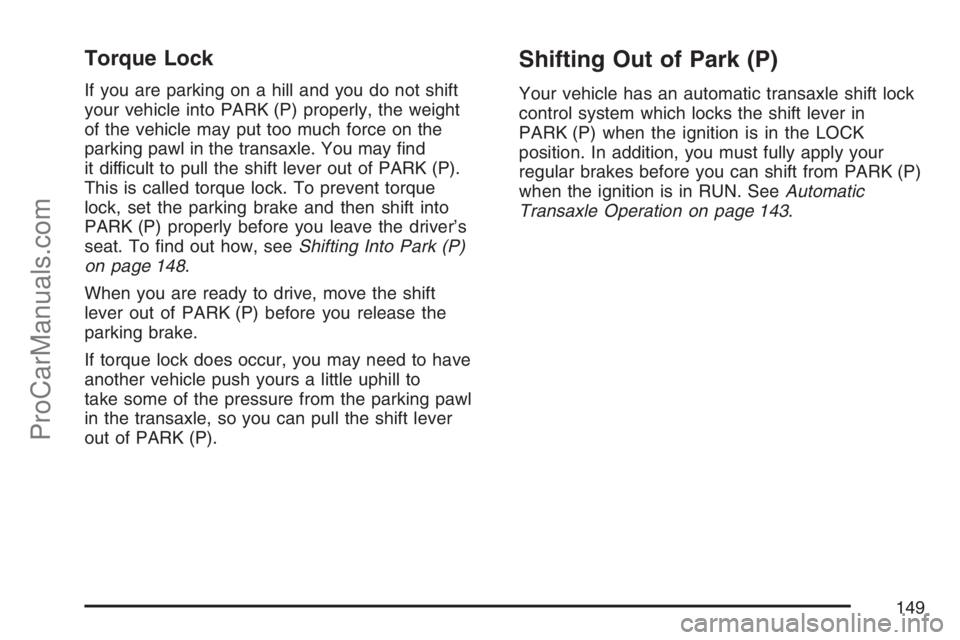
Torque Lock
If you are parking on a hill and you do not shift
your vehicle into PARK (P) properly, the weight
of the vehicle may put too much force on the
parking pawl in the transaxle. You may �nd
it difficult to pull the shift lever out of PARK (P).
This is called torque lock. To prevent torque
lock, set the parking brake and then shift into
PARK (P) properly before you leave the driver’s
seat. To �nd out how, seeShifting Into Park (P)
on page 148.
When you are ready to drive, move the shift
lever out of PARK (P) before you release the
parking brake.
If torque lock does occur, you may need to have
another vehicle push yours a little uphill to
take some of the pressure from the parking pawl
in the transaxle, so you can pull the shift lever
out of PARK (P).
Shifting Out of Park (P)
Your vehicle has an automatic transaxle shift lock
control system which locks the shift lever in
PARK (P) when the ignition is in the LOCK
position. In addition, you must fully apply your
regular brakes before you can shift from PARK (P)
when the ignition is in RUN. SeeAutomatic
Transaxle Operation on page 143.
149
ProCarManuals.com
Page 150 of 570
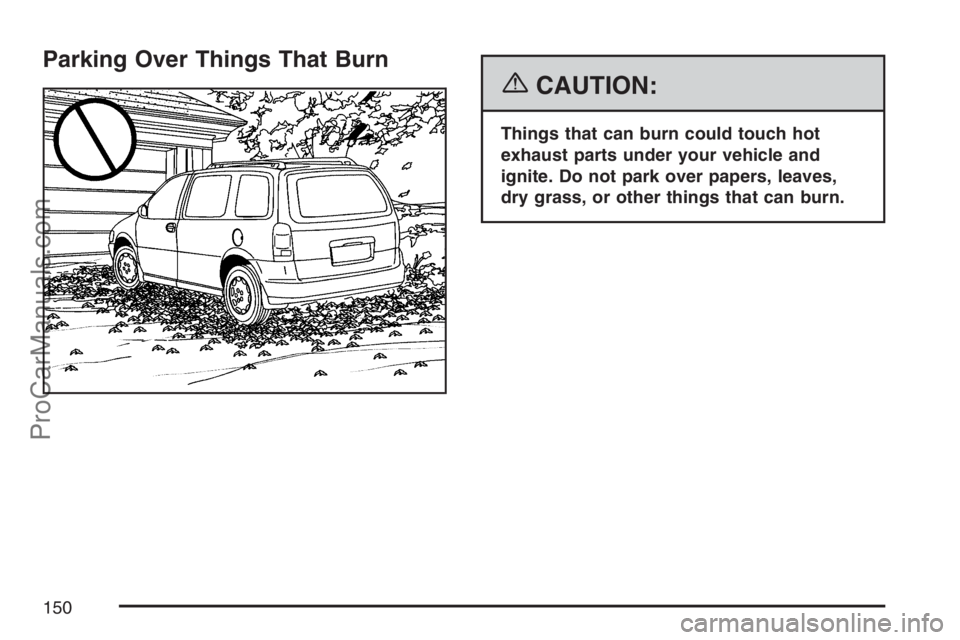
Parking Over Things That Burn
{CAUTION:
Things that can burn could touch hot
exhaust parts under your vehicle and
ignite. Do not park over papers, leaves,
dry grass, or other things that can burn.
150
ProCarManuals.com